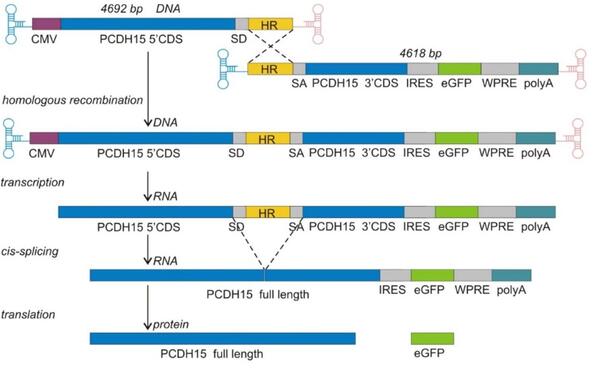|
Mutations in the PCDH15 gene cause a devastating deafness and blindness known as Usher syndrome type 1F. Patients usually present with profound congenital hearing loss and absence of vestibular function, and develop retinitis pigmentosa in the second decade that usually progresses to complete blindness. To develop a therapy for Usher 1F, we have explored different methods to deliver a functional copy of the gene for PCDH15 to the hair cells of the inner ear and the photoreceptor cells of the retina. This is challenging because the PCDH15 gene is large and won’t fit in an AAV vector. We tried three strategies to overcome the size limitation. |
|

|
|
Dual-AAV delivery of a long gene. Representation of an established method for encoding a large protein in two different AAV capsids. A sequence promoting homologous recombination (HR) joins DNA from the two capsids; after transcription, splice donor (SD) and splice acceptor (SA) site mediate splicing out of the HR sequence to create a full-length mRNA. In our application, the AAVs encode PCDH15; eGFP is also expressed under an IRES. |
|
|
In one strategy, we divided the PCDH15 coding sequence in half, and put each half in a separate vector. Each AAV construct included a region to promote homologous recombination, flanked by a splice donor or splice acceptor site, so that after recombination and transcription the recombination sequence is spliced out, leaving the full-length coding sequence. We packaged these dual AAVs in the AAV9-PHP.B vector, and injected them into the inner ears of a mouse model of Usher 1F. Immunocytochemistry showed that the PCDH15 was expressed by hair cells and located at the tips of stereocilia. Scanning electron microscopy showed that the degeneration of hair bundles normally observed in the Usher 1F mouse model was prevented. ABR testing after 30 days demonstrated near-complete rescue of hearing for low and middle frequencies. Finally, a vestibular deficit in this mouse model was prevented by treatment with the dual vectors encoding PCDH15. |